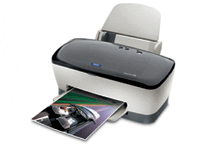|
|
MacEase |
|
|
More Info on These and Other Highly Rated Utilities
Other Reviews Parallel to USB Printer Adapter QPS Que! M3 80 GB FireWire Drive The Orb Drive -- Is it Worth the Wait? Cool Accessories For Your PowerBook
General Tips PCI Cards --
An Easy and Inexpensive Way to Expand the Power of Your
Mac Powerful Protection For Your Mac |
by Steve Becker
Company: Epson
America The C80 comes with an impressive list of specifications that include: 20 ppm text output; variable droplet sizes down to 3 picoliters; 2880 x 720 dpi resolution; DuraBrite™ pigment inks that Epson says are water resistant and lightfast up to 70 years; individual color cartridges; an entirely new and quieter print engine; both a USB and a Parallel port; and a 5000 page per month duty cycle. Additionally, unlike previous Epson ink jet printers, the C80's ink cartridges may be removed and then reinstalled. Also, each cartridge includes a microchip that keeps track of how many droplets have been produced by the cartridge -- the chip even separately tracks the count of each droplet size the cartridge produces so that it can determine the precise amount of ink that has been used. Epson says that the new, large, and individually replaceable cartridges used with the C80 result in a lower cost per page for ink. The C80 comes in an attractive plastic case that looks and feels as though it's constructed with good quality materials. However, I prefer front-mounted controls to the top-mounted controls and indicator lights that are on the C80. The software for the C80 comes on a CD, and installation of the software is both fast and easy. For testing purposes, I installed the C80's software on a Beige Desktop G3/300 that's running OS 8.6. Also installed on this Mac are the drivers for both an Epson Stylus Color 800 and 860. These drivers coexisted peacefully with each other on the G3, and I was able to switch among the printers without experiencing any problems. The first surprise that occurred when using the printer was a pleasant one; it's the quietest Epson printer I've ever used! I was also pleased by the relatively short charging cycle that's required by the C80 (some older Epson printers could take close to 5 minutes to charge their systems when turned on after a moderate period of inactivity). I tested the C80 for both speed and quality when printing text and images. To provide a basis of comparison, I ran the same tests on the same computer using a Stylus Color 860. Although Epson claims the C80 can print 20 ppm in Economy (draft) mode, 14 ppm was the maximum performance I observed when printing multiple copies of a one-page letter -- still, this is almost twice as fast as the SC 860. Printing a 4x5 photo on Photo Ink Jet paper at 1440 dpi took 2 minutes on the C80 and 2 minutes, 10 seconds on the SC 860. Printing with larger images or higher resolution output increased the performance differential between the two printers. From a quality standpoint, the C80 is capable of producing text and photo output that's similar to that of the SC 860 (this is good news, as the SC 860 produces excellent photo and very good text output). However, while the automatic settings of the SC 860 software consistently produced excellent results with photos, it was often necessary to use the "PhotoEnhance" and manual settings on the C80 to get results of similar quality. And occasionally, even manually adjusting the settings didn't yield satisfactory results (pictures looked dull, with poor color fidelity). Since the C80 and its pigment inks are capable of producing excellent images, it appears that Epson needs to perform some additional tuning with the C80's driver. By the way, Epson is now selling a premium 24-pound paper they call "Epson Premium Bright White Paper." A 500-page ream of the paper retails for $8.99, and it features a brightness of 108+ and a whiteness of 155. I used this paper during my testing of the C80 and found it yielded impressive results with both the SC 860 and the C80. While the paper doesn't provide the image detail of Epson's Photo Quality Ink Jet paper, it can produce some striking results for less than two cents per page (it also works well with text). Considering that the C80 is using more stable inks than the SC 860, is faster than the SC 860 when printing both text and graphics, is quieter than the SC 860, has a smaller minimum droplet size than the SC 860 (3 vs. 4 picoliters), and has a considerably lower SRP than did the SC 860, the C80 is an impressive printer! For a general purpose home/small business ink jet printer, the Epson C80 will be at the head of its class and set the standards by which other SOHO ink jet printers will be judged if Epson works out the kinks in its software. Pros: Relatively fast output, uses fade and water-resistant pigment inks, individually replaceable color cartridges, capable of excellent graphic/photo output and very good text quality at 720 dpi and above, bargain price. Cons: Doesn't live up to Epson's claimed ppm rating, inconvenient location of controls, software needs additional work. © Steve Becker. All rights reserved. |
